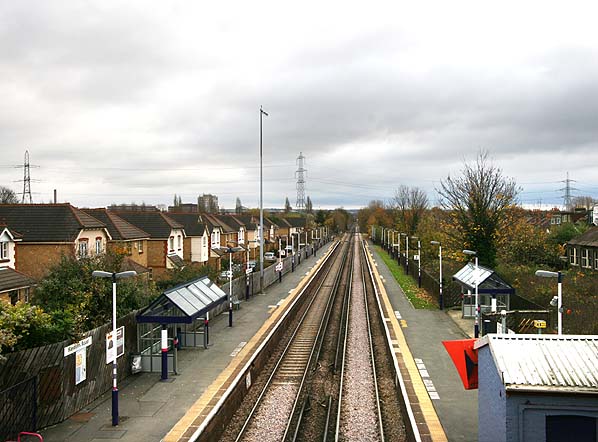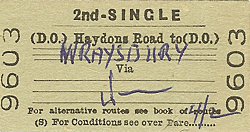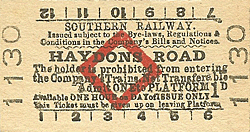
Station Name: HAYDONS ROAD
|
| Date opened: | 1.10.1868 |
| Location: | East side of Haydons Road |
| Company on opening: | London & South Western Railway and London Brighton & South Coast Railway Joint |
| Date closed to passengers: | Still open |
| Date closed completely: | Still open |
| Company on closing: | Still open |
| Present state: | Still open |
| County: | London |
| OS Grid Ref: | TQ260712 |
| Date of visit: | November 2008. |
|
Notes: The station was opened as Hayden's Lane and was renamed Haydons Road on 1st October 1889. The station was the only intermediate station on the northern loop of the Tooting - Wimbledon line and had two side platforms. The station buildings were almost identical to those at Merton Abbey and consisted of a stationmaster's house and booking office with a small awning on the 'up' platform. and a brick waiting shelter on the 'down' platform. There was a signal box at the east end of the 'up' platform which controlled access to the goods yard which was sited some distance east of the station close to the River Wandle.
The signalbox was replaced by a ground frame but the goods yard was enlarged. After the mid 1950's traffic was once again in decline and even rush hour trains weren't well used. Haydons Yards closed on 5th December 1966. The stationmaster's house and all other buildings have now been demolished and replaced by a new brick booking office on the 'up side of the line and two small bus type shelters; the station is staffed during the weekday morning rush hour and Saturday morning. There is a half hourly service to Luton and Sutton. BRIEF HISTORY OF THE TOOTING MERTON & WIMBLEDON RAILWAY
The line was double track throughout, the line through Merton being justified by promise of freight traffic from the copper mills at Merton Abbey where a siding was provided. At first only LBSCR trains used the TM&W, working between London Bridge and Wimbledon by both routes to and from Tooting Junction, but the 1865 Act had given the LSWR running powers to Tulse Hill and on 1 January 1869 a Kingston to Ludgate Hill service was started, this utilised both arms of the TM & W. although most of the twelve daily trains between Kingston and Ludgate Hill ran via the Merton line.
In 1893 of the 16 down trains between London Bridge and Tooting Junction, five continued to Wimbledon via Merton Abbey, returning via Haydon’s Road, the remainder reversing this route. Both routes were well used during rush hours but with the introductions of trams and motor buses after 1910 there was little off peak traffic.
In the late 1920s and 1930s, Merton saw industrial expansion and a siding was laid from the Merton Abbey track into the new Lines Brothers Triang toy factory in Morden Road. Other private sidings served the Eyre Smelting Works and the New Merton Board Mills at Merton Abbey. As late as 1960 there were still two return goods workings daily from Norwood to Merton Abbey and one on Saturdays to Hackbridge, but with factory closures and increased use of road transport, loadings fell, and after the last revenue train ran coal down to Merton Abbey on 1 May 1975 the track was quickly lifted.
Tickets from Michael Stewart. Sources:
Click on station name for other stations on the Wimbledon - West Croydon line: Merton Park, Morden Road, Mitcham, Mitcham Junction, Beddington Lane, Waddon Marsh & West Croydon See also the Tooting Merton & Wimbledon Railway: Merton Abbey See also the St. Helier Estate Railway |
old1.jpg)

old2.jpg)
Photo from John Mann collection

 |
 |
 |
 |

|
| Last updated: Sunday, 21-May-2017 11:05:27 CEST | © 1998-2008 Disused Stations |






 Home Page
Home Page